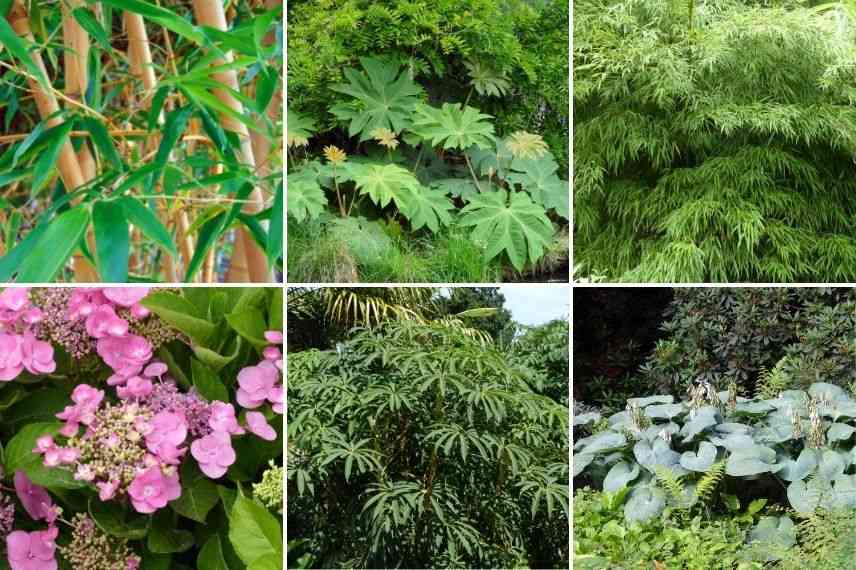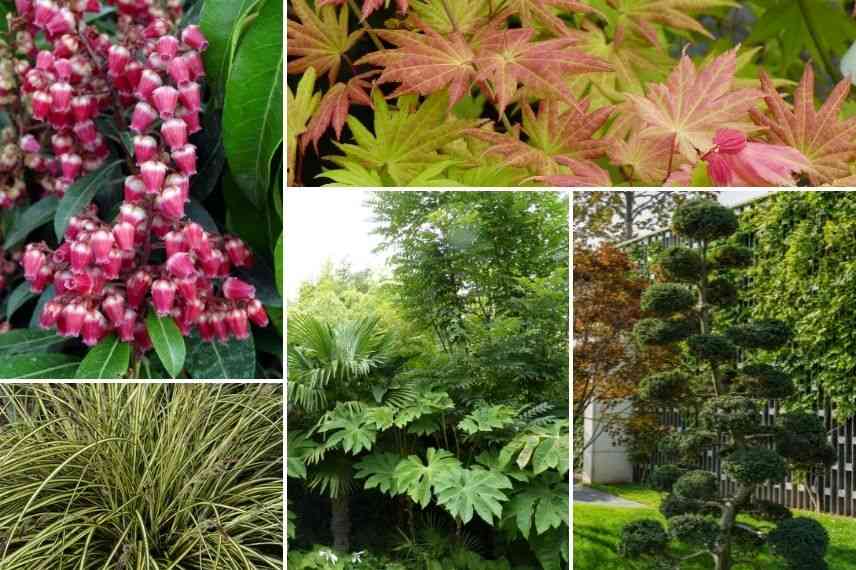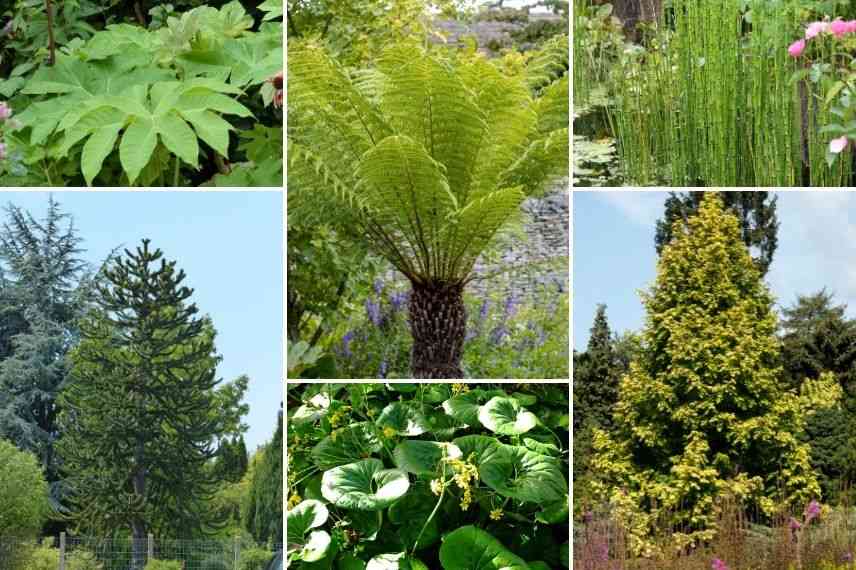
Tetrapanax: 5 Pairing Ideas
Create atmospheres with strong character!
Contents
The Tetrapanax, or Rice Paper Tree, is an exotic bush with a striking design. Planted for its immense, lobed leaves, it reaches about 4 m and adds an architectural touch to the garden. Fond of warm and humid environments, its hardiness is medium, but once established, it can withstand temperatures around -12 °C and can regrow from the base if its aerial parts freeze. It lends itself to various types of landscaping and the creation of different style atmospheres.
What companion plants should you offer it? Discover 5 types of associations, suitable for city gardens or larger spaces, and impart a Japanese, tropical, seaside, or even… prehistoric style to your garden!
An urban jungle
Beautiful plant associations are not just for owners of large gardens. Patios, terraces, and even urban balconies provide opportunities to create green oases where one can momentarily forget the hustle and bustle of the city. Due to its growing conditions, Tetrapanax requires companions that, like it, appreciate non-scorching situations. Combine several pots together, for instance, by including bamboos, which, when cultivated this way, remain easily manageable. Phyllostachys nigra rewards you with its beautiful canes, black at ripeness, while they are yellow in Phyllostachys aureosulcata ‘Aureocaulis’. Non-running bamboos are also excellent candidates, often adopting a very flexible habit, like Fargesia, while being shorter. Chimonobambusa tumidissinoda ‘Microphylla’ has an almost weeping habit. A bit more delicate to grow, Schefflera taiwaniana is quite hardy and can withstand short frosts of around -12 °C.
In the foreground, the choice is also vast and depends on your tastes and aspirations. There’s nothing stopping you from installing Hydrangea macrophylla, the large-headed hydrangeas, although some varieties offer a more refined flowering, like Hydrangea ‘Mousmee’. For more colours, turn to easy-to-grow perennials with beautiful flowers, which bloom throughout the year. For winter, Heathers and Hellebores are reliable choices. Spring sees the emergence of the corollas of Caucasian forget-me-nots and Bleeding hearts. In summer, Liriopes join the display, before the Japanese anemones take over in autumn. Also focus on the decorative foliage of Heucheras and Hostas, as well as bulbs, which are easy to grow and reliably return each year.

Phyllostachys aureosulcata ‘Aureocaulis’, Tetrapanax papyrifera ‘Rex’, Chimonobambusa tumidissinoda ‘Microphylla’, Hydrangea ‘Mousmee’, Schefflera taiwaniana, and Hosta ‘Big Daddy’
A tropical atmosphere
The immense, dissected foliage of Tetrapanax invites exoticism, a quality further enhanced by pairing it with plants that have equally tropical appearances, such as a New Zealand flax. Quite tender, Phormium enjoys bright, sheltered locations and develops a clump of lance-shaped leaves, with colours varying from one species and variety to another. For a tonal effect, Phormium tenax offers solid green foliage. Phormium ‘Dark Delight’, half the height (1 m), provides a marked contrast with its deep purple hues, just like the variety ‘Jester’, which features shades of pink, red, bronze, and green.
Unmissable, Palms transport us to distant, exotic lands. The tallest should be placed in the background and can provide beneficial shade for your Tetrapanax. This is the case with the famous Chinese windmill palm, hardy down to -15 °C, or the more tender but less common Mexican fan palm, which is much larger and grows quickly. Smaller specimens, like the dwarf sabal, which does not exceed 2 metres, can be placed further forward. Don’t forget the Bananas, which are also heavily imbued with exoticism. Musa basjoo is the most common in the territory due to its good hardiness (-15 °C), but in milder regions, try Musa velutina, a species with pink flowers.
The coastal Banksia, whose vegetation disappears below -10 °C but regrows from the stump, forms a bush or small tree with yellow spike-like inflorescences appearing in spring. Much hardier, the Yucca is appreciated for its sculptural foliage and white flowering, but you should place it in a sunnier spot. Finally, hesitating between a fern and bamboo, Elegia capensis is a feathery, airy perennial, thriving in cool, well-drained soil and partial shade.

Tetrapanax papyrifera ‘Rex’, Banksia integrifolia (photo rexness), Phormium ‘Jester’, Musa basjoo, and Trachycarpus fortunei
Discover other Tetrapanax
View all →Available in 3 sizes
A garden with a Japanese atmosphere
Thanks to its origins, Tetrapanax is one of the plants that can be used to create gardens in the Japanese style. Pair it with the must-have Japanese Maples, with their characteristic foliage that is so beautifully coloured in spring and especially in autumn. The Conifers, trimmed into clouds, known as Niwaki, are emblematic of this style of landscaping. Choose suitable species that lend themselves well to this art, such as the Japanese Pine.
When it comes to foliage, that of the Sacred Bamboos is evergreen. Depending on the varieties, it can be golden, green, red, or variegated, and it boasts a white summer flowering, often followed by an abundant fruiting of bright red berries. Camellias, Rhododendrons and Azaleas bring colour with their flowering in a wide range of tones, and many of them have the advantage of also being evergreen, just like the Pieris. These can range from about thirty centimetres to over 3 metres in height, and are decorative both for their changing evergreen foliage and their spring flowering of white, pink, or more rarely red bell-shaped flowers, as seen in Pieris Japonica ‘Valley Valentine’.
For groundcover, consider Hostas with their lush foliage (to be protected from slugs), the Ophiopogon (of which the ‘Nigrescens’ variety is a deep black) or the Hakonechloa, a lovely grass with an irresistible fountain-like habit. Deciduous, the latter can be replaced by evergreen Carex, such as Carex oshimensis ‘Everillo’, with golden foliage, or Carex ‘Evergold’, whose fine linear foliage is variegated with green and yellow.

Pieris japonica ‘Valley Valentine’, Acer palmatum ‘Shirasawanum Moonrise’, Carex oshimensis ‘Evergold’, Tetrapanax papyrifera ‘Rex’ and Niwaki cloud conifer
A seaside garden
Resistant to sea spray, Tetrapanax thrives in warm, humid conditions, often found in coastal climates. It can therefore be integrated into a seaside garden, provided it is sheltered from strong winds that can damage its leaves. To accompany it, bushes like Cordylines, which also have a striking appearance, make a lovely combination. The Strawberry tree, with its autumn flowering and edible fruits, or the Oleander, with summer corollas in various colours, sometimes fragrant, provide permanent structure. With varieties ranging from 50 cm to about 3 metres, the Escallonia is also a classic in coastal gardens.
In terms of perennials, Agapanthuses and their more or less spherical heads add rhythm to the bed, either planted in groups or scattered here and there. The Sea holly, which you should place in sunnier spots, also showcases its spiky, steel-blue foliage, topped in summer by balls of flowers of the same hue. Among all these plants with strong graphic forms, it can be interesting to insert grasses, which bring both lightness and movement. If you have enough space, why not consider the Provence reed. Arundo donax ‘Variegata’ also features very bright variegated foliage.
More restrained, the Diamond grass is nonetheless remarkable, its spikes being among the best at capturing light. Miscanthus comes in varieties from 1 m to 3 m, and they are appreciated for their lovely fountain-like habit as well as their flowering, with some taking on beautiful autumn hues, such as Miscanthus ‘Malepartus’ or ‘Ghana’ which do this so well. Smaller, Pennisetum can mark the corner of a bed or even create aesthetic and easy-to-maintain borders. Finally, the Carex have the advantage of being evergreen for many, maintaining interest throughout the year.

Tetrapanax papyrifera, Eryngium maritimum, Cordyline australis ‘Southern Splendour’, Nerium oleander ‘Emilie’ and Arundo donax ‘Variegata’
A 'prehistoric' garden
Often referred to as “T-Rex”, Tetrapanax alludes to the sharp claws of the dinosaur of the same name, thanks to its leaves. So why not be tempted to create a “prehistoric” garden, filled with plants whose origins date back to ancient times, or whose appearance allows for a leap into the past?
The Araucaria, capable of growing into a tree around fifteen metres tall, features horizontal branches adorned with densely imbricate evergreen leaves, giving it a strange yet fascinating appearance. Metasequoia can become a giant, but the ‘Gold Rush’ variety reaches about fifteen metres, making it suitable for medium-sized gardens. Its fern-like foliage starts light yellow and ends the season in rusty tones before falling.
Also evoking the Cretaceous period, Dicksonia antarctica is one of the most hardy tree ferns. It forms a silky stipe topped with large, finely cut leaves held like a parasol. It’s impossible to mention prehistoric-looking plants without naming the Japanese Cycas, with its distinctive silhouette. Not very hardy, it is best reserved for gardens less affected by severe and lasting frost. Much hardier and also very ancient, the Winter Horsetail produces cylindrical, naked stems marked with black rings. It requires soil that remains cool and can, like Tetrapanax, colonise space, but its vertical graphic form provides a lovely counterpoint. You can complete the scene with an Acanthus with architectural foliage, evergreen in mild climates, and whose pale pink and purple inflorescences are borne on tall vertical stems. A Hosta with oversized foliage, such as the ‘Empress Wu’ variety, along with a Farfugium ‘Gigantea’ will transport you to another world, as if lost in history.

Tetrapanax papyrifera ‘Rex’, Dicksonia antarctica, Equisetum hyemale, Araucaria araucana, Farfugium japonicum ‘Gigantea’ and Metasequoia glyptostroboides ‘Gold Rush’
- Subscribe!
- Contents

































Comments